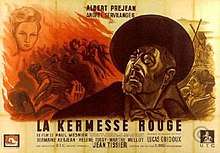The Scarlet Bazaar
The Scarlet Bazaar (French: La kermesse rouge) is a 1947 French historical drama film directed by Paul Mesnier and starring Albert Préjean, Andrée Servilanges and Jean Tissier.[1]
| The Scarlet Bazaar | |
|---|---|
 | |
| Directed by | Paul Mesnier |
| Produced by | André Mallet Jacques Panhaleux Guillaume Radot Hubert Vincent-Bréchignac |
| Written by | Paul Mesnier Francis Vincent-Bréchignac |
| Starring | Albert Préjean Andrée Servilanges Jean Tissier |
| Music by | Maurice Thiriet |
| Cinematography | Georges Million |
| Edited by | Émilienne Nelissen |
Production company | Union Technique Cinematographique |
| Distributed by | Les Films Ti Breiz |
Release date | 23 April 1947 |
Running time | 85 minutes |
| Country | France |
| Language | French |
It was shot at the Buttes-Chaumont Studios in Paris. The film's sets were designed by the art director Marcel Magniez.
The film portrays the fictional rivalry between two painters, a man and wife, that concludes with an incident based on a real-life 1897 fire in Paris.
Main cast
- Albert Préjean as Claude Sironi
- Andrée Servilanges as Agnès Bonnardet-Sironi
- Jean Tissier as René de Montbriant
- Germaine Kerjean as Mme Bonnardet
- Lucas Gridoux as L'antiquaire
- Émile Drain as Le révérend dominicain
- Léon Arvel as M. Bonnardet
- Hélène Tossy as Tante Élisabeth
- Marthe Mellot as Rose de St-Aubin
- Nina Myral as Éléonore de St-Aubin
- Marcelle Rexiane as La gouvernante
- Colette Régis as La duchesse d'Alençon
gollark: Unless you get a used computron of some kind and buy a GPU.
gollark: I would recommend something like this (https://pcpartpicker.com/guide/DHTwrH/entry-level-amd-gaming-build) but with the GPU/CPU balance shifted a bit and maybe other cost savings.
gollark: What do you intend to do with it?
gollark: *How* low? It might be worth upgrading a used thing.
gollark: Do you have something in mind already which you want to improve, or what? If not, PCPartPicker has decent build guides.
References
- Burnett p.62
Bibliography
- Burnett, Colin. The Invention of Robert Bresson: The Auteur and His Market. Indiana University Press, 2016.
This article is issued from Wikipedia. The text is licensed under Creative Commons - Attribution - Sharealike. Additional terms may apply for the media files.